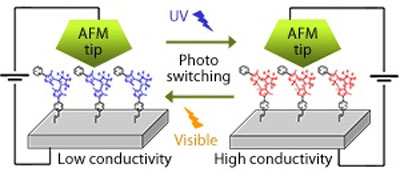| Aug 15, 2011 |
Inorganic chemistry: At the flick of a switch
|
|
(Nanowerk News) The absorption of light provides some molecules with the energy necessary to switch from one chemical arrangement, or isomer, to another. This mechanism, called photochromism, could be exploited to make materials that are light-sensitive, with a host of possible applications in optics and electronics. The difficulty, however, has been in fixing light-activated molecules to material surfaces in a way that they retain their isomer-switching functionality.
|
|
Hiroshi Nishihara and colleagues from the University of Tokyo in Japan have now successfully used this mechanism to create a molecular electrical switch that flicks on and off upon exposure to light at different wavelengths ("Reversible On/Off Conductance Switching of Single Diarylethene Immobilized on a Silicon Surface").
|
 |
| Photochromic molecules attached to a silicon substrate create an optically controlled electrical switch.
|
|
The photochromic molecule used by Nishihara and his team to achieve this functionality is diarylethene, a type of molecule that can exist in one of two isomers, each with very different electrical and optical properties. The 'closed' isomer, for example, has a deep blue color whereas the 'open' form is colorless. Diarylethenes are a particularly good choice for photo-switching applications because they are resilient to changes in temperature.
|
|
Nishihara and his team started by modifying their silicon substrate with hydrogen. "Passivating silicon with hydrogen in this way avoids the surface formation of silicon dioxide, which creates an undesirable electrically insulting barrier," explains Nishihara. They then synthesized a molecule comprising diarylethene with an acetylene molecule at one end, which allowed the diarylethene to be attached to the silicon surface by forming bonds with the hydrogen atoms.
|
|
The isomeric form of the diarylethene could be switched by exposing the surface to ultraviolet or visible light. The researchers found that the closed isomer, which is formed on exposure to ultraviolet light, was significantly more conductive than the visible-light-induced open isomer when a current was passed through the surface via an atomic force microscope tip (see image). This allowed the functionalized surface to act as an electrical switch activated by exposure to light at these two wavelengths.
|
|
"The covalent attachment of diarylethene directly to silicon surfaces, which are ubiquitous in the electronics industry, could be a route to organic–inorganic hybrid devices," says Nishihara. The material holds promise for use in information storage, optical switching and optoelectronics.
|

